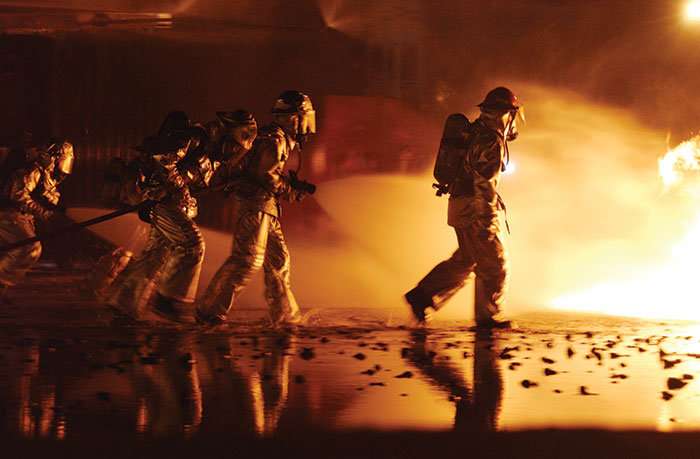Persistent pain experienced by firefighters

A recently released Western co-authored study is providing an eye-opening look into how physical pain and discomfort have become a way of life for many firefighters across the country.
According to the study, the longer a firefighter's career the greater the chances of suffering from persistent neck, back and limb pain. Further, 70 per cent of all active firefighters studied said they had experienced at least some pain in their arms, legs and back during a 13-month span.
"They call themselves the 'working wounded' sometimes because they're well aware they're suffering musculoskeletal issues," said Joy MacDermid, a Schulich School of Medicine & Dentistry professor affiliated with the Bone and Joint Institute.
Co-authored through the McMaster School of Rehabilitation Science, Prevalence and distribution of musculoskeletal disorders in firefighters are influenced by age and length of service was published in a recent edition of the Journal of Military, Veteran and Public Health. Exploring injuries among working Hamilton, Ont., firefighters, the research is the first paper to quantify – by age, sex and length of service – who is most prone to suffering musculoskeletal injury, and where and how intense that pain is.
"A lot of them have to retire early or leave the job they love because of musculoskeletal injuries," said MacDermid, Director of Clinical Research at the Hand and Upper Limb Clinic at St. Joseph's Health Care London.
Even though it's a high-risk job, no one should accept or assume injuries are an expected component of the work, she said.
"Firefighters, both men and women, are all aware of that risk of injury and are prepared to accept that risk because they have such a strong commitment to serve their communities. But when there's a high risk of injury, there's always an opportunity to analyze how to reduce the risk."
During a 13-month span, firefighters tracked whether they experienced pain and logged its location and severity. Of the 294 respondents, 30 per cent experienced no musculoskeletal pain during that time. Of male participants, 42 per cent experienced pain in multiple sites: shoulders, knees, back and/or neck.
By contrast, 2013 Statistics Canada data shows 16 per cent of adult Canadians sustained limiting activity-limiting injuries in the previous 12 months.
While the research did not identify how firefighters' injuries took place – and some of them may have occurred outside of the job – the physically demanding work takes a cumulative toll, said Rob D'Amico, a captain with the Hamilton Fire Department.
"If we're pulling or dragging something, or walking upstairs with high-rise gear and our bunker gear, that can add an extra 100 pounds to our weight," D'Amico, Secretary of the Hamilton Professional Fire Fighters Association, said.
Add to that the heft of hoses and the stresses of working in cramped quarters where they often must pivot and crouch, colleagues' bodies are often under a lot of strain.
"Our members get hurt doing their duties. Maybe some of those duties can be done differently and using different techniques – and having a sense of what the injuries are is a good first step."
Firefighting since 1991, D'Amico has suffered a few injuries along the way, although "nothing that took me out of my job for more than a few days." Others, he knows, continue to work through the pain on the job.
D'Amico noted firefighters took part in the study with the association's endorsement and using the facilities of the fire department, whose leadership was "100 per cent supportive" of the research.
They are part of a national program called Firefighter Injury Reduction Enterprise: Wellness Enabled Life & Livelihood (FIREWELL).
MacDermid, who serves as FIREWELL project director, said the data suggests the cumulative effects of pulling, twisting and turning have long-term impact on firefighters' bodies.
Firefighters, older than the median age of 42, and/or with more than the 15 years of service, experienced greater incidence of pain and more severe pain. Compared with their younger counterparts, the older firefighters were:
- Four times more likely to report neck pain;
- Twice as likely to report back pain; and
- Twice as likely to have pain in their upper and lower limbs.
Among younger firefighters, upper-limb pain (often, injuries to the rotator cuff in their shoulders) was the most common.
The study included eight women, too few to make many definitive conclusions, but enough to show they too bear a higher-than-average burden of musculoskeletal injury. That highlights the need both for early intervention and injury prevention that includes better-fitting gear. ("Women firefighters are not just 'size small' men," MacDermid noted.)
The study emphasizes the need for early assessment and intervention; examining how firefighters do their tasks; and reviewing how the team works together for ergonomic efficiency and injury prevention.
Results show gear and equipment needs to be both functional and safe; and processes must be refined to keep firefighters healthy.
Researchers are now working on video-based analysis of firefighters' tasks and the kinematic effects of various tasks to determine whether they can be adapted for injury prevention.
Screening for upper-limb musculoskeletal disabilities might also help with early intervention and treatment, according to the study.
More information: Ahmed Negm et al. Prevalence and distribution of musculoskeletal disorders in firefighters are influenced by age and length of service, Journal of Military, Veteran and Family Health (2017). DOI: 10.3138/jmvfh.2017-0002




















